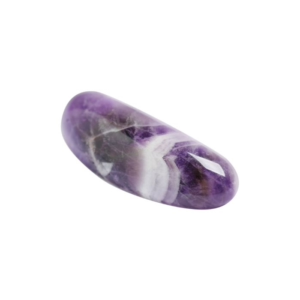Purple Jasper
Purple Jasper is a striking variety of jasper, a type of chalcedony that is known for its beautiful and diverse colors. Jasper is an opaque, fine-grained form of quartz, and purple jasper is particularly appreciated for its rich shades of violet, lavender, and occasionally deep purple. As a variegated gemstone, purple jasper often has unique patterns and swirls of color, making each piece distinct.
Characteristics of Purple Jasper:
- Color:
- Purple jasper can range from light lavender or mauve to deep, rich purple. The color is often uneven, with lighter areas mixing with darker hues, creating beautiful, one-of-a-kind patterns.
- It is commonly banded or mottled, with the purple tones blending into shades of white, cream, brown, and even green or yellow.
- Composition:
- Like all jasper, purple jasper is composed of microcrystalline quartz (a form of silica), along with various minerals that contribute to its color and patterns. The specific shades of purple are often caused by the presence of iron and manganese.
- Transparency:
- Jasper is always opaque, and purple jasper is no exception. Its smooth, dense structure makes it ideal for ornamental use.
- Hardness:
- Purple jasper has a hardness of 6.5 to 7 on the Mohs scale, making it durable enough for use in jewelry and other items that require longevity.
- Luster:
- It has a waxy or dull luster, which is typical for jasper. When polished, it can develop a smooth, attractive sheen.
Formation:
Purple jasper, like other forms of jasper, forms in sedimentary environments, typically in volcanic rocks or hydrothermal deposits. The specific minerals present in the surrounding environment, along with the temperature and pressure conditions, determine the range of colors and patterns found in the stone. Iron oxide is a major contributor to the purple hues, while other trace minerals like manganese can intensify or alter the color.
Geographic Locations:
- Brazil: Known for producing a wide range of colorful jaspers, including purple varieties.
- India: Has deposits of purple jasper, often found in regions with volcanic activity.
- United States: Various states, including Arizona and Oregon, have sources of jasper with purple hues.
- Mexico: A notable source of high-quality jasper, including purple varieties, often used in carvings and beads.
Uses:
- Jewelry:
- Purple jasper is often cut into cabochons, beads, or slices to create striking rings, necklaces, bracelets, and earrings.
- The rich colors and unique patterns make it a popular choice for bohemian or earthy jewelry designs.
- Ornamental Items:
- Jasper, including purple varieties, is frequently used in carvings, figurines, and decorative objects. It can be polished into spheres, obelisks, and other forms for display.
- Metaphysical Properties:
- Grounding and Protection: Purple jasper is believed to have grounding properties and is often used as a protective stone. It is thought to help stabilize emotions and protect the wearer from negative energies.
- Emotional Healing: Like other jaspers, purple jasper is believed to help soothe emotional wounds, calm the mind, and bring a sense of balance and well-being.
- Physical Healing: Some believe purple jasper can be beneficial for improving circulation, boosting energy, and enhancing the immune system.
- Chakra Healing: It is associated with the crown chakra, helping to foster spiritual growth, inner peace, and connection to higher consciousness. It can also aid in balancing the root chakra, promoting stability and grounding.
Care and Maintenance:
- Cleaning:
- Purple jasper is fairly durable but should be cleaned gently with warm, soapy water and a soft cloth. Avoid using harsh chemicals or ultrasonic cleaners, as these can damage the stone.
- Handling:
- While jasper is generally tough and resistant to breaking, it can be scratched by harder stones, so handle purple jasper jewelry and items with care to avoid damage.
- Storage:
- Store purple jasper jewelry separately from harder gemstones to prevent scratching. Use a soft pouch or a compartment in a jewelry box.
Rarity and Value:
Purple jasper is less rare than some other precious gemstones but is still considered a semi-precious stone. High-quality pieces with rich, deep purple hues and striking patterns are valued by collectors, but purple jasper remains relatively affordable compared to more expensive stones like amethyst or tanzanite.
Conclusion:
Purple jasper is a beautiful and versatile gemstone, offering a range of colors and patterns for those seeking something unique and aesthetically pleasing. Whether used in jewelry, ornamental objects, or for its healing properties, purple jasper provides both visual appeal and metaphysical benefits. Would you like to know more about how purple jasper is used in metaphysical practices or specific jewelry-making techniques?

Leave a Reply
Want to join the discussion?Feel free to contribute!